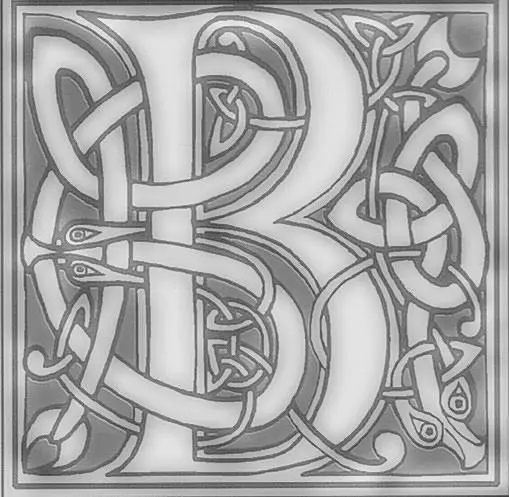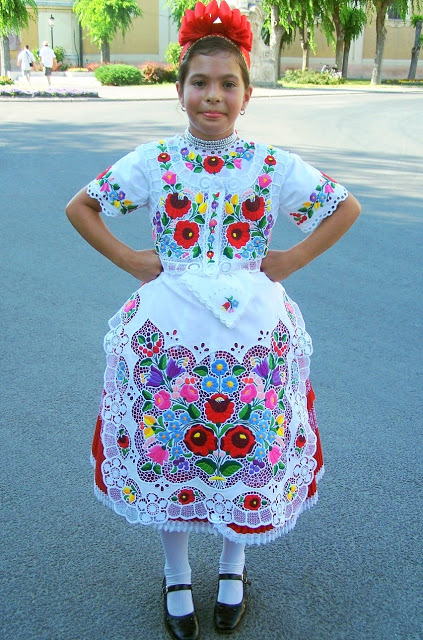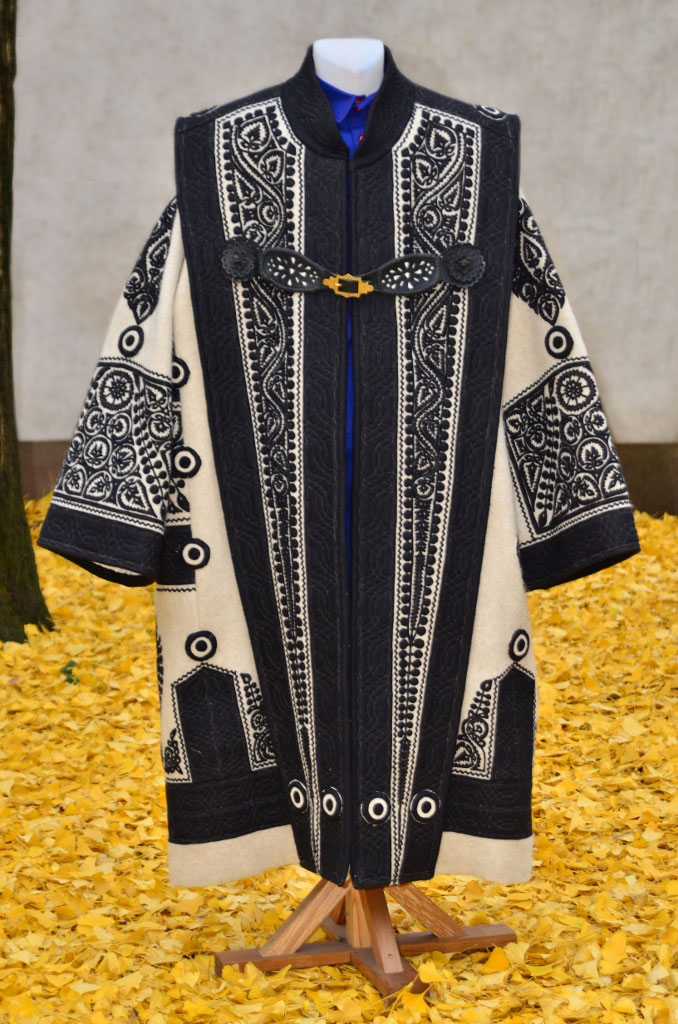The traditional dress of Hungary is an exceedingly beautiful feature of the diverse and varied culture of this country. According to a census in 2011, the population consists of Hungarians (83.7%), Croats (0.2%), Germans (1.3%), Romani (3.1%), Romanians (0.3%) and Slovaks (0.3%). The designs of traditional costumes are unique compared to other Eastern European countries, but they are no longer commonly used by Hungarians nowadays, being mainly worn while dancing Hungarian folk dances (especially the Csárdás) or for special festivities.
The traditional costumes of Hungary are split into four regions: The Great Plain, Transdanubia, Transylvania and Upper Hungary (The Highlands of Northern Hungary). The costumes within each of these regions can also be quite diverse. In Hungarian rural society, clothing traditionally showed the wearer’s position in the community, his or her age, rank and wealth.
Hungarian costumes follow the “Sunday variant” style of folk art. In this style, work clothes are simple and utilitarian. Only those of young women are occasionally brightened by a colourful scarf or a similar item. For Sundays or holidays, however, entire villages seem to blossom as their inhabitants don their colourful Sunday “best”. The contrast is usually most pronounced in women’s clothes. Men’s wear tends to be more sombre, with dark colours predominating. (There are important exceptions, such as in the Matyo region, where young men dress just as colourfully as the girls.) There is usually a great deal of variation between the clothes worn by the two sexes, but an unusual feature of the Transylvanian costumes is that items for women and men are often identical in tailoring, colour and ornamentation, while the age of the owner is distinctly illustrated by the use of different colours.
As said above, day-to-day clothes were usually plain and the Sunday “best” was highly decorated. The town of Mezokovesd in Upper Northern Hungary was the scene of an interesting episode concerning the ornateness of the Sunday costumes. By 1924, the town elders had decided that the church-going clothes of the villagers had become too luxurious, and they requested that the local pastor ban gold lace and gold embroidery from the church. As a consequence, the girls and women of Mezokovesd burned all their finery in front of the church. The luxurious use of colours, however, has remained a common practice in this region.
History
Hungary has, like the rest of central Europe, been subjected to many different influences starting from prehistoric times. This was followed by centuries of successive habitation by Celts, Romans (35 BCE to 4th century CE), Huns, Ostrogoths, Lombards, Slavs, Gepids and Avars. In 895 CE, the Magyars settled in the Carpathian Basin. The Magyars are originally from the forested area between the Volga River and the Ural Mountains and they became the ancestors of modern-day Hungarians. The Magyars are called Hungarians in other languages as it was erroneously thought that they were descended from the Huns.
In the 16th century, the region was divided into three, with the north-western part under the rule of the Hapsburgs (Austria), while the eastern part and central regions were under Ottoman rule. The Kingdom of Hungary was removed from Ottoman rule in 1718, coming under Hapsburg rule. The ethnic composition of Hungary was fundamentally changed as a consequence of the prolonged warfare with the Turks. The Austrian-Habsburg government also settled large groups of Serbs and other Slavs in the depopulated south and settled Germans (called Danube Swabians) in various areas, but the Magyar were not allowed to settle or re-settle in the south of the Great Plain.
In October 1918, Hungary’s union with Austria was dissolved. On 4 June 1920, new borders for Hungary were established resulting in Hungary losing 71% of its territory and 66% of its population to its neighbours. About one-third of the ethnic Hungarian population became minorities in the neighbouring countries. During the Second World War, Hungary sided with Nazi Germany and Italy. At the end of the war, Soviet Russia took over the country making it a satellite state until 1989, when Hungary became an independent state as the Third Republic.
Embroidery
The finest achievements in the textile sector in Hungary is the embroidery which varies from region to region. Hungarian embroidery is characterised by great versatility and its variants may be classified according to the base material (textiles, leather or thick felt), to the colours used (white-on-white or variegated), or to the many techniques utilised.
The present style of Hungarian folk art took shape in the beginning of the 18th century, incorporating both Renaissance and Baroque elements, depending on the area, as well as Persian Sassanid influences. The principal decorative themes consist of flowers and leaves, with sometimes birds or spiral ornaments. The most frequent ornament is a flower with a centrepiece resembling the eye of a peacock’s feather.
Around 150 years ago, the style of embroidery was not so colourful as nowadays: the wool available for embroidery was of limited colours, with blue and red or black and red patterns being common in that era. Later, when more colours became available, the floral decorations became bigger and multi-coloured. However, the Oriental style embroidery of Kalotaszeg in Transylvania usually uses only a single colour – red, blue or black. Today, the embroidery motifs applied to women’s wear are also used for tablecloths and wall decorations.
The finest embroideries are considered to come from Sárköz in Transdanubia and the Matyóföld in the Great Hungarian Plain. In the Sárköz region, the women’s caps show black and white designs as delicate as lace. In some areas, the embroidery is combined with openwork, which may be embellished with so much Richelieu work that very little remains of the original cloth between the embroidered motifs.
Women’s wear
The common principle of women’s clothes in all four regions of Hungary is that they consist of two separate units: a bodice and a lower part, each of which consists of several layers. The basic item of dress is a loose-fitting linen shift (chemise) with long or short sleeves, over which is worn a waistcoat, a short jacket or a sheepskin cape. The costumes are then completed by a wide variety of headgear and footwear.
The lower part of the costume consists of one or more loose-fitting petticoats or underskirts (in parts of the Hungarian Plain it was not uncommon for women to wear well over a dozen), a skirt and an apron. The length and tailoring of the skirt, and the number and material of the petticoats vary greatly from region to region. The skirts are often highly pleated and are most commonly sewn from a solid medium-tone coloured material (red, rose, blue, violet, green, etc.). There are one or two bands of lace or ribbon sewn on midway down the skirt, and sometimes along the hem as well. The skirts can nowadays also be made of flowered print material.
The white linen or cotton apron worn with the costume tends to be minimally gathered at the sides at the top, rounded on the bottom. The apron served and serves to present to the world the wearer’s embroidery skills.
As said above, women’s clothing has become more vibrantly coloured in modern times as more colour options have become available. However, with advancing age, women wear increasingly plainer clothes; the favourite colour of youth, red, is slowly replaced by green, blue, and finally black. In some regions, the ancient custom of white for mourning has been retained.
Like among the Germans, in certain areas, Hungarian brides used to wear a plain black dress made of silk (as said previously Hungarians wore white for mourning). The same dress was also worn for funerals and when the woman died she was buried in it. Otherwise, the traditional Hungarian bridal dress was very colourful and elaborately embroidered. Three bright and vibrant colours were usually repeated in the bride’s dress and in her large and elaborate headdress, which also included woven wheat as a symbol of fertility. Under the dress were many petticoats.
Throughout the entire Hungarian-speaking area, women wore their hair long and never cut it. Damage to the hair signifies injury to the individual her- or even himself, which is why cutting hair off was one of the strictest ancient punishments in Hungary (even until the 19th century). Many Hungarian superstitions involve the hair; for example, keeping a lover by eating a bit of his or her hair.
The name for unmarried girls was hajadon (bare-headed), which refers to their not wearing anything on their heads. Formerly girls braided their hair into two or three, and later one braid, and tied coloured ribbons into each braid. In a few places in the rural regions, girls pinned up their hair into a bun made of many small braids (e.g. in Kalocsa, Sióagárd). Married women wore their braided hair pinned in a knot on the top of their head. In fact, the last act of a Hungarian wedding is the pinning up of the hair of the young wife (felkontyolás).
On holidays and special occasions, young unmarried girls wore a párta, an ornately decorated headpiece on their heads, which covers the forehead but leaves the top of the head uncovered. The párta was valued as the symbol of maidenhood. In some regions, girls wore a ribbon folded a number of times to form a bow instead. Even simple wreaths of flowers were worn on the head.
Hungarian folk beliefs assign a greater magical power to a married woman’s hair than to a girl’s, and that is the reason why a married woman must always keep her head covered. The coif or bonnet-style head covering (főkötő) serves this purpose; the shape, colour and form of which vary greatly according to region, the age of the wearer, the weather, and the occasion.
For festive occasions, an under-headdress usually holds the bun of hair in place, and a more ornate one is fitted on top of that. The ornate headdress is stiffened with cardboard and various versions developed in the Hungarian-speaking regions. The most usual coifs are shaped like a cylinder or a column. A special headdress is worn by Matyo women (in the area around the town of Mezokovesd in Northeastern Hungary). It is rather unique as it consists of a material base with a number of pompoms attached to it.
In certain regions, after the birth of her first child, a young wife wears a red headdress. The colours of her headdress then become darker as the number of her children increases. Finally, she wears black, the colour befitting a grandmother.
During the past decades, the traditional ornate headdresses have disappeared almost completely in day-to-day life. They have been replaced by a headscarf (babushkas) tied over the head, whose colours again darken as the wearer grows older.
The footwear for the women traditionally consisted of mules (small backless clogs with a short heel). Red boots are often worn by folklore dancers.
Men’s wear
Hungarian men’s costumes also vary from region to region though to a lesser extent. However, there are some items characteristic for each locality. In general, they all consist of tight-fitting boots, trousers [older style wide-legged linen or woollen culottes (gatya) or more modern black, blue or grey narrow-legged or jodhpur style trousers], a shirt that can be accompanied by a waist-length waistcoat (dolmany) or a coat, and a hat; all with varying degrees and types of braiding and/or embroidery (see above).
One of the most famous parts of men’s wear originated in Transdanubia, namely the colourfully embroidered long frieze-coat (cifra szűr). This style of coat first appeared in the western region of Hungary during the early part of the 19th century and within 20—30 years the style swept throughout entire country. The coat then went through several stylistic changes and has ended up in a black-and-white version in easternmost Transylvania. The highly embroidered version is intended for festive occasions and is a coveted object for every boy approaching adulthood.
At one time, much of a Hungarians’ wardrobe might have been made out of animal hides, but in more recent times the use of leather has become restricted to coats, capes, etc. The suba, a full-length sleeveless fur cape worn with the fur on the inside, the bekecs, a hip-length form-fitting coat, and the kodmon, a shorter jacket, are still made.
They are often decorated with heavy embroidery or appliqué work using dyed leather. The suba, is made out of as many as twenty sheepskins and so it is usually possessed by the head of a family or a wealthy peasant.
At one time, the majority of men’s head coverings were made from animal hide or woollen felt. The material used for the fur cap is sheepskin, normally black in colour and peaked in shape. It is generally worn in the winter, even today. The famous Cumanian cap or cap of Tur was made of felt. Recent research proves that even during the first half of the last century this hat was worn by Hungarians all over the country, and not only by the Cumanians. It is a tall, cylindrical form of headgear, and may have come to the peasants from the old traditional soldier’s outfit.
The wearing of wide-brimmed felt hats (outlaio) spread during the first half of the last century. It can be read in the official ordinances of that time that the wearing of these wide-brimmed hats was prohibited. Gradually, the brim of the hats decreased in size. Their smaller-brimmed successors still may be seen worn on the heads of the husbandmen of the Hortobágy. The wide-brimmed hat style lasted for a long time among the Székelys and Csángós, and also among the neighbouring peoples (e. g. Slovaks). Inexpensive straw hats appeared from the middle of the last century, and became popular in certain parts of the Hungarian-speaking territory especially during the summer.
References
http://folkcostume.blogspot.de/2011/11/costume-of-kalocsa-bacs-kiskun-county.html
http://folkcostume.blogspot.de/2014/06/costume-and-embroidery-of-mezokovesd.html
http://goeasteurope.about.com/od/hungary/ss/Hungarian-Folk-Costumes.htm#step6
http://mek.oszk.hu/02700/02790/html/100.html
http://mek.oszk.hu/02700/02790/html/105.html
http://www.ask.com/world-view/clothing-traditional-hungary-9f92ea0b410af348
http://www.thelovelyplanet.net/traditional-dress-of-hungary/
https://en.wikipedia.org/wiki/Culture_of_Hungary#Embroidery
Pictures
1) Matyo embroidery – https://europebetweeneastandwest.files.wordpress.com/2014/12/matyo-embroidery-a-wealth-of-beauty-and-complexity.jpg
2) Woman’s waistcoat done in Richelieu work – http://folkcostume.blogspot.de/2011/11/costume-of-kalocsa-bacs-kiskun-county.html
3) Pleated skirt – http://folkcostume.blogspot.de/2011/11/costume-of-kalocsa-bacs-kiskun-county.html
4) Black wedding dress – http://folkcostume.blogspot.de/2011/11/costume-of-kalocsa-bacs-kiskun-county.html
5) Párta – http://www.cecili.eoldal.hu/img/mid/57/menyecske-parta.jpg
6) Ribbon headdress – http://folkcostume.blogspot.de/2011/11/costume-of-kalocsa-bacs-kiskun-county.html
8) Matyo pompom hats – http://hungarianfolk.com/wp-content/uploads/2012/12/Matyo-pom-pom-hats1.jpg
9) Typical gatya trousers, shirt and waistcoat – http://mek.oszk.hu/02100/02115/html/img/2-268c.jpg
10) Cifra szűr – http://www.hnp.hu/uploads/files/igazgatosag/Hortob%C3%A1gyi%20Nemzeti%20Parki%20term%C3%A9k%20v%C3%A9djegyesei%20-%202014/porkolabf_cifraszur_01.jpg
11) Suba – http://www.natgeocreative.com/comp/05/328/432651.jpg
12) Young man in a decorated kodmon – http://hungaria.org/uploaded/images/.thumbnails/20040610-083553_6.jpg
13) Boy in a Cumanian cap (Print from 1903) – http://ecx.images-amazon.com/images/I/516NX0X1ZdL._SY300_.jpg
14) Man in an outlaio hat with blue gatya and shirt – http://static.panoramio.com/photos/large/9771832.jpg
15) Typical tight-fitting Hungarian boots – http://f.tqn.com/y/goeasteurope/1/S/I/N/-/-/hungarian-traditional-boots.jpg (Embroidery can even be found on men’s boots)
(1.9.0)















